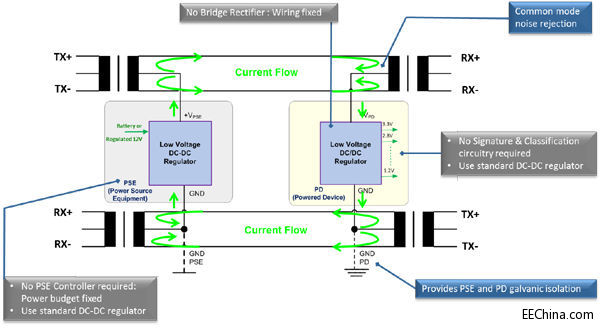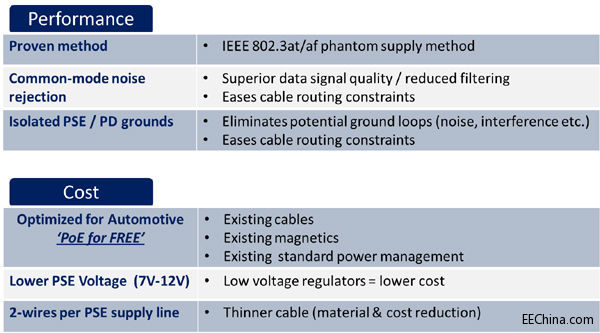As the demand for higher security in cars continues to increase, the addition of advanced driver assistance systems (ADAS) to automotive features is a trend. Nowadays, rear view parking sensors and cameras have long been popular. Looking ahead, increasingly sophisticated, sensor-based anti-collision technologies will provide lane departures, road signs, traffic lights and pedestrian recognition. Standard Ethernet has proven to be an attractive solution for ADAS applications. The reason is that this technology enables high-bandwidth data transmission with low-cost unshielded twisted pair. The adoption of standard solutions is not difficult to understand; there are multiple vendors in the supply market that allow economies of scale to be achieved and minimize the cost of ownership. But the overall benefits gained by using standard Ethernet from multiple complementary IEEE standards, such as Power over Ethernet (PoE), are often overlooked. Interestingly, when deployed with Power over Ethernet (PoE) After the standard Ethernet, the automotive market has significantly more profit than most other markets.
This article refers to the address: http://
Installing multiple camera sensors in a car inevitably increases wiring capacity, which is not what automakers want to see. Undoubtedly, remotely mounted vehicle sensors also require power to be supplied with the data lines, so each sensor requires a pair of wires to power the devices remotely. IEEE 802.3af (standard) and IEEE 802.3at (higher power) propose a method of distributing power through the same wires as the data. With these technologies, remote sensor devices using standard Ethernet interfaces no longer require the use of additional wires. In addition to no additional wiring, automotive applications can be significantly benefited by optimizing standard Power over Ethernet (PoE) equipment, as all the benefits of this powerful technology can be realized without any additional system cost.
To understand how this is done, let's take a look at the basic principles of IEEE802.3af/at Power over Ethernet (PoE) operation, as shown in Figure 1.

Figure 1: IEEE802.3af/at Power over Ethernet device phantom power supply.
The Power over Ethernet (PoE) architecture consists of two elements; the first is a power supply that is supplied by a power supply unit (PSE) and received by a power supply unit (PD). Before collecting the three-phase process of the power supply, the PD must first be detected and classified by a dedicated PSE controller.
1. Explore - PSE checks if it is connected to a valid, compatible PD device
2. Classification - PSE checks the power required by the PD
3. Operation - If 1 and 2 above are valid and the PSE provides sufficient power, it will enable the VPSE voltage (between 44V and 57V).
The Power over Ethernet (PoE) voltage VPSE is applied to the center tap of a standard 100BASE-TX Ethernet transformer; this technique is called "phantom power." Next, current flows through the two wires to the center tap of the Ethernet transformer on the PD side. Each winding carries half of the opposite polarity current, so the total DC current flowing through the transformer is actually zero. A key advantage of the “phantom power†approach is the common mode noise suppression for the PD-side transformer, which is only available for the 100BASE-TX Ethernet interface. Any noise picked up from the PSE or along the twisted pair will be coupled to the Ethernet differential signal as common mode noise and eliminated.
The PD side needs to be equipped with a bridge rectifier to achieve rectification, and it is insensitive to polarity when the RX and TX line pairs are accidentally switched.
Providing a ground loop to the PSE through the center tap of the other transformer is the second key advantage; PD and PSE ground current isolation. This isolation is important to avoid radiated ground loops when there is a difference in ground potential on each side (which may be important to the vehicle). This advantage is also unique to 100BASE-TX Ethernet.
Designed for the car
It is also interesting to explore the optimization effects of using these IEEE PoE methods for automotive applications, as shown in Figure 2 below.

Figure 2. Automotive 100Base-TX PoE optimized with "phantom power".
The main difference is that there is no need to use a traditional PSE controller. For automotive applications, the exploration and classification stages are redundant since the PD side is always known and fixed. The interface between the front unit and the rear view camera module is a good example. The relatively high PSE controller can be replaced with a low cost DC-DC regulator. This regulator provides shutdown protection in the event of a current overload fault. With a lower PoE voltage VPSE for a more suitable car, such as 12V (compared to 48V specified by IEEE802.3af/at), a low cost/low voltage DC-DC regulator can be used on the PD side. When operating with a 12V PoE, the rated power of 6W or more per port is still achievable. If you need more power, you can use a higher PoE voltage (or increase the rated current magnetism).
On the PD side, since the car wiring is also fixed, there is no need to use a universal bridge rectifier.
Table 1. Advantages of a car-optimized 100Base-TX PoE.

While optimizing and reducing costs, standard Power over Ethernet (PoE) devices for automotive applications can take advantage of the "phantom power" approach. In particular, the common mode noise suppression of PD and PD/PSE ground insulation highlighted in the above summary table.
A closer look at the optimizations shown in Figure 2 reveals that all of the key benefits of IEEE PoE are successfully achieved without any additional cost; no additional cabling, existing standard Ethernet magnetism, and existing standard power management. Therefore, the automotive market has a unique value proposition in the concept of “free Power over Ethernet (PoE)!â€.
Blow Suction Vacuum Cleaner: This mini usb vacuum cleaner is with both blow and suction function, it not only can be used for suction dust, also can be used for blowing dust. This blow suction portable vacuum cleaner can also clean some water.
Handheld Mini Vacuum Cleaner : This small vacuum cleaner can be used for cleaning hidden dirty of notebook keyboard, printer, pet food, office, kitchen table, or other small household appliances.
Portable wireless mini Car Vacuum Cleaner : This usb car vacuum cleaner can be used for cleaning car vent, dashboard, storage cabinet, sand, dust, paper, food debris, and so on.
Wireless Handheld Vacuum Cleaner: this Small Vacuum Cleaner power supplied by usb port, which is very easy and convenient to use and store.
Easy to use: this mini Cyclone Vacuum cleaners` filter can be washed by water. Just open the dust pot and take it out, then wash it clean and reuse after it dry.
This Multifunctional Rechargeable Vacuum Cleaner is a good home helper for you. As a small Portable Vacuum Cleaner, it is very easy and convenient to use and to store everywhere you like.Blow Suction Vacuum Cleaner
Small Vacuum Cleaner,Shark Pet Vacuum,Black And Decker Vacuum,Cheap Vacuum Cleaners
SHENZHEN HONK ELECTRONIC CO., LTD , https://www.honktech.com
